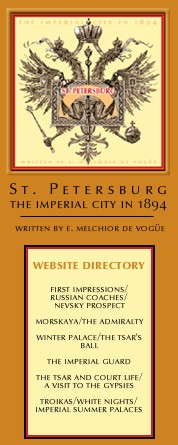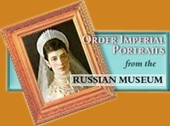


 | 
THE IMPERIAL GUARD
Outside the Winter Palace it is in military ceremonies that the Czar can most often be seen and approached. For the last century Russian sovereigns have rivalled those of Prussia in their strictness on this point; they have pressed the whole male population into the army and into the observance of the minute rules of the service, and society is deeply imbued with the military spirit. For nothing in the world would the late Emperor Alexander II. have missed the grand manoeuvres of the Sunday parade in the St. Michael's Riding-school; he went there on the 13th of March, in spite of the entreaties of his minister, Count Loris-Melikov, and it was at the end of the ceremony on the Catherine Canal that he was struck down by the assassins. When the Czar receives the Sunday report in front of the two battalions, who take the service of the week in turn, he is surrounded by his numerous military escort, old generals take their places once more at the head of the regiments of the Guard in which they began their career, and think it an honor to file past their chief. Foreign ambassadors, with a numerous suite in uniform, follow the exercises with earnest scrutiny, and on these occasions can approach the Emperor with ease. The diplomatic soldier rides for a moment shoulder to shoulder with the Czar, and can exchange a few words with him on the events of the day. The words which have influenced contemporary history more than any other fell from the Imperial lips in the St. Michael's Riding-school, whispered to an attentive ear between two orders to "present arms!"

St. Issac's Cathedral These manoeuvres of the Guard take place in a vast covered enclosure, completely closed and heated, where a whole regiment of cavalry can deploy with ease in the depth of winter. After the churches these enclosures are the first thing to attract the attention of the visitor in this capital of a religious and military nation. The officers give brilliant entertai ' nments in them, organizing equestrian quadrilles with hardy Amazons as partners, in the presence of crowds of well-dressed spectators. Scarcely a week passes but what the Emperor assists, in addition to the Sunday parade, at one of these entertainments, in honor, perhaps, of the patron saint of the regiment, or of one of the many jubilees celebrated with a view to cultivating the military spirit, or on the anniversary of a victory, or on the fiftieth birthday of a chief illustrious-for his long and faithful service in the army. The manoeuvres of the Guard are to the people of St. Petersburg what the meetings of the Legislative Assembly are to the Parisians: the occasions on which the very genius of the nation is revealed with all its earnest and its frivolous prepossessions.

A Member of the Imperial Guard on Horseback These fÚtes present a unique opportunity for seeing military Russia in all its glory and all its epic luxury. Let us take our places, in the early days of April, on one of the stands on either side of the royal Pavilion at the farther end of the Champs de Mars. The great world is collecting to assist at the grand spring review. The Champs de Mars is situated in the heart of the city, between the Court Quay, the Summer Garden, and the dreary-looking Castle of St. Michael, abandoned behind its moats and drawbridges, deserted as it was forever by the Romanovs after the night on which Paul I. was found dead, victim of a mysterious tragedy. The whole of the Guard is massed before us, numbering at least 25,000 men, sometimes more. Other States can boast a military force equal to this, but no other can show its army under conditions so magnificent or so picturesque. Every race and every arm of this vast and varied empire is about to defile before us, from the noble mounted Guards, who seem to have stepped forth from the romantic Middle Ages to the still heathen Khirgiz from the Asiatic steppes. Attention! Millions of voices transmit this word of command. "The Emperor!" There he is, coming round the corner of the Champs de Mars. At sight of him all the flags seem to tremble, all the bands unite in one formidable volume of sound to send up to heaven the grand petition of the national hymn, "God save the Czar!" He rides at a slow gallop. Behind him is his escort riding in a pell-mell sort of fashion, uniforms of every color and variety worn by the most illustrious representatives of the Russian nobility alternating with those of ambassadors and military attachÚs of all the European Powers. The master passes in front of his troops, the Empress following him in an open carriage. At the approach of their Majesties the bands of each regiment thunder forth with almost diabolical fury the national hymn; a perfect hurricane of sound accompanies and seems to wrap about the Imperial cavalcade; greetings consecrated by immemorial custom are exchanged between the Czar and his soldiers. "Good- morning, children!" says the Emperor. "We are happy to do well for your Imperial Majesty."
The sovereign pauses opposite to the group of Grand Duchesses, and the march past begins. A platoon of Asiatics leads the way, from the wilds of Oriental Russia, Mussulmans from Khiva and Bokhara, Georgian princes, Tcherkesses, Persians, sturdy-looking Mongols, and Caucasians.
These primitive -looking warriors, armed with spears and bristling with steel, wear long coats of mail over robes of gleaming silk, costly furs, and damascened helmets or Tartar caps. This is the advance - guard of the hordes of Attila as they are pictured in tradition and in popular fancy; they are succeeded by the compact masses of the regular army: first the infantry, Preobrajensky, chasseurs from Finland, soldiers of the Paul Regiment with theirmitre-shaped copper helmets, such as those worn by the grenadiers of Frederick the Great. In accordance with an old tradition, all the men with snub -noses are recruited for this regiment. The foot - soldiers are succeeded by troops of cavalry, living walls of iron and silver vibrating on great war-horses, Knights of the Guard, or mounted guardsmen, followed in their turn by light cavalry, red hussars, mounted grenadiers, and lancers. Then clouds of Cossacks, galloping on their little steeds, pour in from every side of the Champs de Mars, to draw rein, pause, and turn short round in front of the Imperial stand.They put their horses through the exercises of an Arab fantasia; bending low in the saddle, they almost touch the ground, without taking foot from stirrup, to pick up the spear or pistol they have flung down. The artillery brings up the rear, admirably appointed batteries, which dash rapidly along, drawn by six black horses as handsome as any owned by the nobility.
Send your comments on this website to Bob AtchisonVisit other Pallasart Sites on Imperial Russia: Alexander Palace Time Machine | My Name is Anastasia | Nicholas and Alexandra Exhibition | The Life and Tragedy of Alexandra Feodorovna | Pavlovsk Palace | Yelagin Palace | Tsarskoe Selo | Russian Imperial Eggs | Russian Imperial Style | Dining with the Tsars | Gatchina Palace © 1998, 1999 Bob Atchison | Website built by Pallasart Web Design
|







